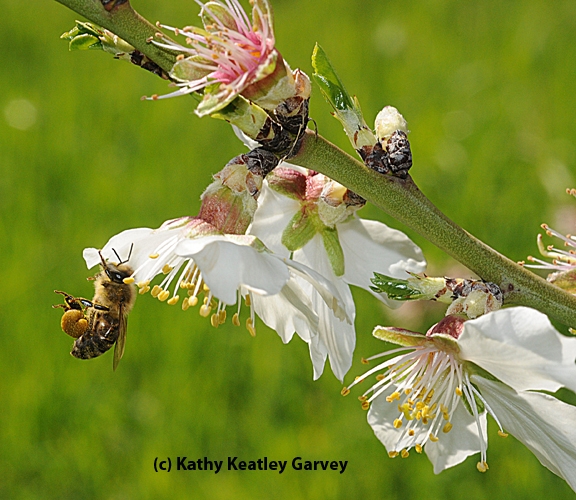
It's critical issue.
Mussen, an Extension apiculturist based at the UC Davis Department of Entomology and Nematology since 1976, says malnutrition is a major factor in the declining bee population. That, along with pesticides, pests, diseases and stress.
"You, no doubt, have lost track of how many times I have stated that malnutrition is a leading factor in our unacceptable annual bee colony loss numbers," Mussen writes in the latest edition of his bimonthly newsletter, from the UC Apiaries, available free on his website.
"I have also stated innummerable times that our synthesized bee diets just cannot match the value of nutrients obtained by bees from a mixture of quality pollens. My concern has been that although we have a very good idea of the protein requirements for honey bees, the rations of essential amino acids honey bees require, and their required vitamins and minerals, etc., we still cannot feed bees on our best diets and keep them alive more than two months in confinement."
"Thus, we are missing some very critical components in our synthesized diets. If we could find those components, could we formulate a diet that would sustain bees in a healthy condition during 'feedlot beekeeping'?"
Mussen touches on a recent study that shows a component in honey, p-coumarin, stimulates "the honey bee immune system to work better."
However, it's not the honey that's doing this.
"Actually," Mussen says, "that chemical is a contaminant of honey that comes from pollen grains that are mixed into the honey during the bees' processing cycle. Thus, the bees need only to consume the pollen to obtain the desired results. How many other minor chemicals are there in pollens that are so useful to honey bee health?"
You'll want to read what he says about floral pollens containing microbes. "If these microbes are really so important to the nutritional needs of honey bees, what are we doing when we introduce antibiotics and fungicides into the system?"
Bottom line: we need more research to see what's going on with pesticide exposures and reduced microbial levels.
Or as Mussen says: "As researchers continue to try to improve upon our supplemental bee feeds, they have to consider the possibility of inoculating a semisold formulation of the diet with fresh pollen and stored pollen so that a natural microbial complex can do its things and make the food appropriately fit for consumption by honey bees."
Attached Images:

Honey bee foraging on a tidy tips wildflower, Layia platyglossa. (Photo by Kathy Keatley Garvey)

Honey bee on a pomegranate blossom. (Photo by Kathy Keatley Garvey)

Honey bee pollinating nectarine blossoms. (Photo by Kathy Keatley Garvey)

Honey bee packing pollen while foraging on an almond blossom. (Photo by Kathy Keatley Garvey)